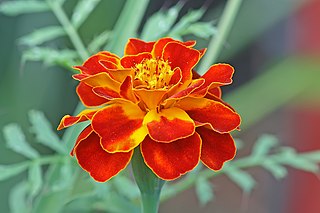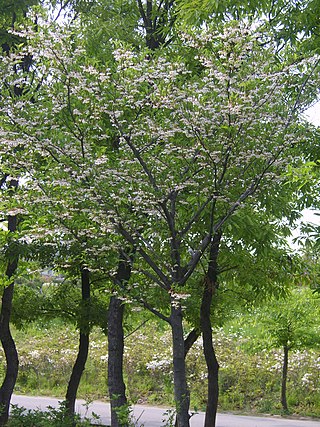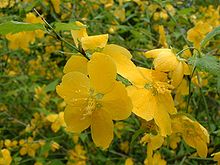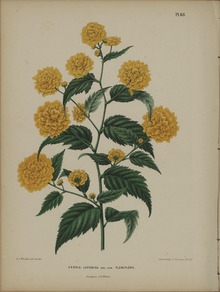
Honeysuckles are arching shrubs or twining vines in the genus Lonicera of the family Caprifoliaceae, native to northern latitudes in North America and Eurasia. Approximately 180 species of honeysuckle have been identified in both continents. Widely known species include Lonicera periclymenum, Lonicera japonica and Lonicera sempervirens. L. japonica is a highly invasive species considered a significant pest in parts of North America, Europe, South America, Australia, and Africa.

Forsythia, is a genus of flowering plants in the olive family Oleaceae. There are about 11 species, mostly native to eastern Asia, but one native to southeastern Europe. Forsythia – also one of the plant's common names – is named after William Forsyth.

Pieris is a genus of seven species of shrubs in the flowering plant family Ericaceae, native to mountain regions of eastern and southern Asia, eastern North America and Cuba. Known commonly in North America as andromedas or fetterbushes, they are broad-leaved evergreen shrubs growing to 1–6 metres tall and 3–10 ft (0.9–3.0 m) wide. The leaves are spirally arranged, often appearing to be in whorls at the end of each shoot with bare stretches of shoot below; they are lanceolate-ovate, 2–10 cm (0.8–3.9 in) long and 1.0–3.5 cm (0.4–1.4 in) broad, leathery textured, and with an entire or serrated margin. The young leaves in spring are typically brightly coloured. The flowers are bell-shaped, 5–15 mm (0.2–0.6 in) long, white or pink, and arranged in racemes 5–12 cm (2.0–4.7 in) long. The fruit is a woody capsule which splits into five sections to release the numerous small seeds.

Tagetes patula, the French marigold, is a species of flowering plant in the family Asteraceae, native to Mexico and Guatemala with several naturalised populations in many other countries. It is widely cultivated as an easily grown bedding plant, with thousands of different cultivars in brilliant shades of yellow and orange.

Weigela is a genus of between six and 38 species of deciduous shrubs in the family Caprifoliaceae, growing to 1–5 m (3–15′) tall. All are natives of eastern Asia. The genus is named after the German scientist Christian Ehrenfried Weigel.

Euonymus japonicus is a species of flowering plant in the family Celastraceae, native to Japan, Korea and China. It is an evergreen shrub or small tree growing to 2–8 m tall, with opposite, oval leaves 3–7 cm long with finely serrated margins. The flowers are inconspicuous, greenish-white, 5 mm diameter. In autumn, orange fruit hangs below the flaring pink seed coverings.

Chaenomeles speciosa, the flowering quince, Chinese quince or Japanese quince, is a thorny deciduous or semi-evergreen shrub native to eastern Asia. It is taller than another commonly cultivated species, C. japonica, usually growing to about 2 m. The flowers are usually red, but may be white or pink. The fruit is a fragrant, hard pome that resembles a quince.

Spiraea japonica, the Japanese meadowsweet or Japanese spiraea, is a plant in the family Rosaceae.

Forsythia suspensa, commonly known as weeping forsythia or golden-bell, is a species of flowering plant in the family Oleaceae, it is native to China.

Skimmia japonica, the Japanese skimmia, is a species of flowering plant in the family Rutaceae, native to Japan, China, and Southeast Asia. Growing to 6 m (20 ft) tall and wide, it is a rounded evergreen shrub with glossy, leathery leaves. It is widely cultivated as an ornamental plant in gardens and parks. Its fragrant flowers are cream-yellow or white, followed on female plants by small, round, red fruits. The plant tolerates a wide range of conditions, including frost, drought, and atmospheric pollution. It is suitable for bonsai and for Chinese gardens.

Aucuba japonica, commonly called spotted laurel, Japanese laurel, Japanese aucuba or gold dust plant (U.S.), is a shrub native to rich forest soils of moist valleys, thickets, by streams and near shaded moist rocks in China, Korea, and Japan. This is the species of Aucuba commonly seen in gardens - often in variegated form. The leaves are opposite, broad lanceolate, 5–8 cm (2.0–3.1 in) long and 2–5 cm (0.79–1.97 in) wide. Aucuba japonica are dioecious. The flowers are small, 4–8 mm (0.16–0.31 in) diameter, each with four purplish-brown petals; they are produced in clusters of 10-30 in a loose cyme. The fruit is a red drupe approximately 1 cm (0.39 in) in diameter that is avoided by birds.

Eriocapitella hupehensis, a species of flowering plant in the buttercup family Ranunculaceae, is native to Asia. The specific epithet hupehensis, which means "from Hupeh province, China", refers to a region where the species is known to occur. In Chinese, it is called dǎ pò wǎn huā huā (打破碗花花), which means "broken bowl flower".

Berberis japonica is a species of flowering plant in the family Berberidaceae, native to Taiwan. Despite the name, it is not native to Japan, though it has been known in cultivation there for centuries. The wild origins of this species have long puzzled botanists, but wild plants in Taiwan, previously known under the name Mahonia tikushiensis, appear most similar to the cultivated forms of B. japonica.
Berberis × hortensis is an interspecific hybrid shrub. Its parents are Berberis oiwakensis and Berberis japonica. It was raised in gardens during the 20th century, and has become an important garden and landscape plant.

Camellia × williamsii is a cultivar group of hybrid evergreen shrubs that are derived from a crossing of Camellia saluenensis with Camellia japonica. It was originally bred in 1923 at Caerhays Castle in Cornwall by John Charles Williams.

Acer palmatum, commonly known as Japanese maple, palmate maple, or smooth Japanese maple (Japanese: irohamomiji, イロハモミジ, or momiji,, is a species of woody plant native to Japan, Korea, China, eastern Mongolia, and southeast Russia. Many different cultivars of this maple have been selected and they are grown worldwide for their large variety of attractive forms, leaf shapes, and spectacular colors.

Styrax japonicus, also known as the Japanese snowbell, is a species of flowering plant in the family Styracaceae, native to Korea, Japan, and Southern China. Growing to 12 m (39 ft) tall by 8 m (26 ft) broad, it is a graceful, spreading deciduous tree with oval, upward-facing leaves which occasionally turn yellow or orange before falling in autumn. Masses of slightly fragrant, bell-shaped white flowers hang from the branches in summer, followed by fruits (drupes) which resemble olives in both shape and colour.
Blumeriella kerriae is a species of fungus in the family Drepanopezizaceae.

Eriocapitella is a genus of flowering plants in the buttercup family Ranunculaceae. Plants of the genus are native to Asia. The generic name Eriocapitella roughly translates to "growing in a small woolly head", which refers to the hairy ovary and fruit of some members of the genus. Cultivated plants are commonly known as fall-blooming anemones.

Eriocapitella japonica is a species of flowering plant in the buttercup family Ranunculaceae. The specific epithet japonica means "from Japan", which is a misnomer since the species is introduced in Japan. It is native to China, Taiwan, and Vietnam.




















